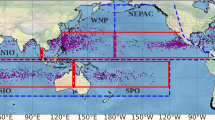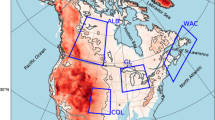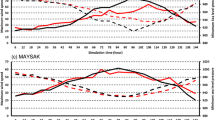Abstract
Extratropical cyclone (EC) is the main source of precipitation at midlatitudes, but its precipitation characteristics change with warming still remains uncertain. Here, using 17 CMIP6 models, ECs in DJF in the Southern Hemisphere are tracked and recorded with concomitant sea level pressure and surface temperatures. EC total precipitation change with warming is decomposed into the contribution from EC number, life duration and precipitation intensity. It is found that decreasing EC total precipitation is strongly related to decreased EC number, with life duration contributing about 1/6 that of EC number change. Increasing EC precipitation intensity offsets the decrease due to EC number. To better quantify EC precipitation intensity change with warming, we employ temperature experienced by ECs instead of regional averaged temperature. A higher precipitation increasing rate per degree of warming (6.05%/K) than previous studies was noted because ECs tend to shift poleward with warming. Furthermore, the noted rate is mainly related to the increase of near-surface temperature (62%), followed by increased EC intensity (23%).









Similar content being viewed by others
Data availability
CMIP6 data is available at https://esgf-node.llnl.gov/search/cmip6/, GPCP data is available at http://gpcp.umd.edu/, ERA-Interim data is available at https://www.ecmwf.int/.
References
Adler RF, Sapiano M, Huffman GJ, Wang J, Gu G, Bolvin D, Chiu L, Schneider U, Becker A, Nelkin E, Xie P, Ferraro R, Shin DB (2018) The Global Precipitation Climatology Project (GPCP) monthly analysis (new version 2.3) and a review of 2017 global precipitation. Atmosphere (basel) 9(4):138
Almazroui M, Saeed F, Saeed S, Islam MN, Siddiqui MH (2020) Projected change in temperature and precipitation over Africa from cmip6. Earth Syst Environ 4(3):455–475
Basu S, Zhang X, Wang Z (2018) Eurasian winter storm activity at the end of the century: a CMIP5 multi-model ensemble projection. Earths Future 6(1):61–70
Bender FAM, Ramanathan V, Tselioudis G (2011) Changes in extratropical storm track cloudiness 1983–2008: observational support for a poleward shift. Clim Dyn 38(9–10):2037–2053
Bevacqua E, Zappa G, Shepherd TG (2020) Shorter cyclone clusters modulate changes in European wintertime precipitation extremes. Environ Res Lett 15(12):124005
Bodas-Salcedo A, Andrews T, Karmalkar AV, Ringer MA (2016) Cloud liquid water path and radiative feedbacks over the Southern Ocean. Geophys Res Lett 43(20):10938–10946
Booth JF, Wang S, Polvani L (2012) Midlatitude storms in a moister world: lessons from idealized baroclinic life cycle experiments. Clim Dyn 41(3–4):787–802
Booth JF, Naud CM, Del Genio AD (2014) Evaluation of ERA-Interim and MERRA cloudiness in the Southern Ocean. J Clim 27(5):2109–2124
Catto JL (2016) Extratropical cyclone classification and its use in climate studies. Rev Geophys 54(2):486–520
Catto JL (2018) A new method to objectively classify extratropical cyclones for climate studies: testing in the southwest Pacific region. J Clim 31(12):4683–4704
Catto JL, Ackerley D, Booth JF, Champion AJ, Colle BA, Pfahl S, Pinto JG, Quinting JF, Seiler C (2019) The future of midlatitude cyclones. Curr Clim Change Rep 5(4):407–420
Chang EKM, Yau AMW (2015) Northern Hemisphere winter storm track trends since 1959 derived from multiple reanalysis datasets. Clim Dyn 47(5–6):1435–1454
Chang EKM, Zheng C, Lanigan P, Yau AMW, Neelin JD (2015) Significant modulation of variability and projected change in California winter precipitation by extratropical cyclone activity. Geophys Res Lett 42(14):5983–5991
Chang EKM, Kim H-M, Wang J (2017) Changes in Northern Hemisphere winter storm tracks under the background of Arctic amplification. J Clim 30(10):3705–3724
Dai P, Nie J (2022) Robust expansion of extreme midlatitude storms under global warming. Geophys Res Lett 49(10):1–10
Dalaiden Q, Goosse H, Lenaerts JTM, Cavitte MGP, Henderson N (2020) Future Antarctic snow accumulation trend is dominated by atmospheric synoptic-scale events. Commun Earth Environ. https://doi.org/10.1038/s43247-020-00062-x
Dee DP, Uppala SM, Simmons AJ, Berrisford P, Poli P, Kobayashi S, Andrae U, Balmaseda MA, Balsamo G, Bauer P, Bechtold P, Beljaars ACM, van de Berg L, Bidlot J, Bormann N, Delsol C, Dragani R, Fuentes M, Geer AJ, Haimberger L, Healy SB, Hersbach H, Hólm EV, Isaksen L, Kållberg P, Köhler M, Matricardi M, McNally AP, Monge-Sanz BM, Morcrette JJ, Park BK, Peubey C, de Rosnay P, Tavolato C, Thépaut JN, Vitart F (2011) The ERA-Interim reanalysis: configuration and performance of the data assimilation system. Q J R Meteorol Soc 137(656):553–597
Douville H, Raghavan K, Renwick J, Allan RP, Arias PA, Barlow M, Cerezo-Mota R, Cherchi A, Gan TY, Gergis J, Jiang D, Khan A, Pokam Mba W, Rosenfeld D, Tierney J, Zolina O (2021) Water cycle changes. In: Masson-Delmotte V, Zhai P, Pirani A, Connors SL, Péan C, Berger S, Caud N, Chen Y, Goldfarb L, Gomis MI, Huang M, Leitzell K, Lonnoy E, Matthews JBR, Maycock TK, Waterfield T, Yelekçi O, Yu R, Zhou B (eds) Climate change 2021: the physical science basis. Contribution of Working Group I to the sixth assessment report of the intergovernmental panel on climate change. Cambridge University Press, Cambridge, pp 1055–1210. https://doi.org/10.1017/9781009157896.010
Durran DR, Shi X (2014) The response of orographic precipitation over idealized midlatitude mountains due to global increases in CO2. J Clim 27(11):3938–3956
Eichler TP, Market P (2019) The climatology and interannual variability of cyclone tracks in the National Center for Environmental Prediction’s climate forecast system model for the Southern Hemisphere. Int J Climatol 39(13):4967–4984
Falco M, Li LZX, Menéndez CG, Carril AF (2019) The influence of South American regional climate on the simulation of the Southern Hemisphere extratropical circulation. Clim Dyn 53(9–10):6469–6488
Govekar PD, Jakob C, Catto J (2014) The relationship between clouds and dynamics in Southern Hemisphere extratropical cyclones in the real world and a climate model. J Geophys Res Atmos 119(11):6609–6628
Grieger J, Leckebusch GC, Raible CC, Rudeva I, Simmonds I (2018) Subantarctic cyclones identified by 14 tracking methods, and their role for moisture transports into the continent. Tellus a: Dyn Meteorol Oceanogr 70(1):1–18
Grise KM, Medeiros B (2016) Understanding the varied influence of midlatitude jet position on clouds and cloud radiative effects in observations and global climate models. J Clim 29(24):9005–9025
Grise KM, Son S-W, Correa GJP, Polvani LM (2014) The response of extratropical cyclones in the Southern Hemisphere to stratospheric ozone depletion in the 20th century. Atmos Sci Lett 15(1):29–36
Hanley J, Caballero R (2012) Midlatitude eddies, storm-track diffusivity, and poleward moisture transport in warm climates. J Atmos Sci 69(11):3237–3250
Hawcroft MK, Shaffrey LC, Hodges KI, Dacre HF (2012) How much Northern Hemisphere precipitation is associated with extratropical cyclones? Geophys Res Lett 39(24):1–7
Hawcroft MK, Shaffrey LC, Hodges KI, Dacre HF (2015) Can climate models represent the precipitation associated with extratropical cyclones? Clim Dyn 47(3–4):679–695
Hawcroft M, Dacre H, Forbes R, Hodges K, Shaffrey L, Stein T (2016) Using satellite and reanalysis data to evaluate the representation of latent heating in extratropical cyclones in a climate model. Clim Dyn 48(7–8):2255–2278
Hawcroft M, Walsh E, Hodges K, Zappa G (2018) Significantly increased extreme precipitation expected in Europe and North America from extratropical cyclones. Environ Res Lett 13(12):124006
IPCC (2022) Summary for policymakers. In: Pörtner H-O, Roberts DC, Poloczanska ES, Mintenbeck K, Tignor M, Alegría A, Craig M, Langsdorf S, Löschke S, Möller V, Okem A, Rama B (eds) Climate change 2022: impacts, adaptation and vulnerability. Contribution of Working Group II to the sixth assessment report of the intergovernmental panel on climate change. Cambridge University Press, Cambridge, pp 3–33. https://doi.org/10.1017/9781009325844.001
Joos H (2019) Warm conveyor belts and their role for cloud radiative forcing in the extratropical storm tracks. J Clim 32(16):5325–5343
Kodama C, Iga S, Satoh M (2014) Impact of the sea surface temperature rise on storm-track clouds in global nonhydrostatic aqua planet simulations. Geophys Res Lett 41(10):3545–3552
Kodama C, Stevens B, Mauritsen T, Seiki T, Satoh M (2019) A new perspective for future precipitation change from intense extratropical cyclones. Geophys Res Lett 46:12435–12444
Krasting JP, Broccoli AJ, Dixon KW, Lanzante JR (2013) Future changes in Northern Hemisphere snowfall. J Clim 26(20):7813–7828
LaCasce JH, Graff LS (2014) Changes in cyclone characteristics in response to modified SSTs. J Clim 27(11):4273–4295
Lee J-Y, Marotzke J, Bala G, Cao L, Corti S, Dunne JP, Engelbrecht F, Fischer E, Fyfe JC, Jones C, Maycock A, Mutemi J, Ndiaye O, Panickal S, Zhou T (2021) Future global climate: scenario-based projections and near-term information. In: Masson-Delmotte V, Zhai P, Pirani A, Connors SL, Péan C, Berger S, Caud N, Chen Y, Goldfarb L, Gomis MI, Huang M, Leitzell K, Lonnoy E, Matthews JBR, Maycock TK, Waterfield T, Yelekçi O, Yu R, Zhou B (eds) Climate change 2021: the physical science basis. Contribution of Working Group I to the sixth assessment report of the intergovernmental panel on climate change. Cambridge University Press, Cambridge, pp 553–672. https://doi.org/10.1017/9781009157896.006
Lee J, Hwang J, Son S-W, Gyakum JR (2022) Future changes of East Asian extratropical cyclones in the CMIP5 models. J Clim 35:3305–3315. https://doi.org/10.1175/jcli-d-21-0945.1
Li M, Woollings T, Hodges K, Masato G (2014) Extratropical cyclones in a warmer, moister climate: a recent Atlantic analogue. Geophys Res Lett 41(23):8594–8601
Lombardo K, Colle BA, Zhang Z (2015) Evaluation of historical and future cool season precipitation over the eastern United States and Western Atlantic storm track using CMIP5 models. J Clim 28(2):451–467
Ludwig P, Pinto JG, Reyers M, Gray SL (2014) The role of anomalous SST and surface fluxes over the southeastern North Atlantic in the explosive development of windstorm Xynthia. Q J R Meteorol Soc 140(682):1729–1741
Manton MJ, Huang Y, Siems ST (2020) Variations in precipitation across the Southern Ocean. J Clim 33(24):10653–10670
Michaelis AC, Willison J, Lackmann GM, Robinson WA (2017) Changes in winter North Atlantic extratropical cyclones in high-resolution regional pseudo-global warming simulations. J Clim 30(17):6905–6925
Neale RB, Gettelman A, Field PR, Wood R, Rasch PJ, Morrison H (2008) Midlatitude cyclone compositing to constrain climate model behavior using satellite observations. J Clim 21(22):5887–5903
Neu U, Akperov MG, Bellenbaum N, Benestad R, Blender R, Caballero R, Cocozza A, Dacre HF, Feng Y, Fraedrich K, Grieger J, Gulev S, Hanley J, Hewson T, Inatsu M, Keay K, Kew SF, Kindem I, Leckebusch GC, Liberato MLR, Lionello P, Mokhov II, Pinto JG, Raible CC, Reale M, Rudeva I, Schuster M, Simmonds I, Sinclair M, Sprenger M, Tilinina ND, Trigo IF, Ulbrich S, Ulbrich U, Wang XL, Wernli H (2013) IMILAST: a community effort to intercompare extratropical cyclone detection and tracking algorithms. Bull Am Meteorol Soc 94(4):529–547
O’Gorman PA, Allan RP, Byrne MP, Previdi M (2011) Energetic constraints on precipitation under climate change. Surv Geophys 33(3–4):585–608
Pepler AS, Di Luca A, Ji F, Alexander LV, Evans JP, Sherwood SC (2016) Projected changes in east Australian midlatitude cyclones during the 21st century. Geophys Res Lett 43(1):334–340
Pfahl S, O’Gorman PA, Singh MS (2015) Extratropical cyclones in idealized simulations of changed climates. J Clim 28(23):9373–9392
Phibbs S, Toumi R (2016) The dependence of precipitation and its footprint on atmospheric temperature in idealized extratropical cyclones. J Geophys Res: Atmos 121(15):8743–8754
Priestley MDK, Ackerley D, Catto JL, Hodges KI, Lee RW (2020) An overview of the extratropical storm tracks in cmip6 historical simulations. J Clim 33(15):6315–6343
Raible CC, Messmer M, Lehner F, Stocker TF, Blender R (2018) Extratropical cyclone statistics during the last millennium and the 21st century. Clim past 14(10):1499–1514
Reboita MS, Crespo NM, Torres JA, Reale M, Porfírio da Rocha R, Giorgi F, Coppola E (2021) Future changes in winter explosive cyclones over the Southern Hemisphere domains from the CORDEX-CORE ensemble. Clim Dyn 57(11–12):3303–3322
Roberts JF, Champion AJ, Dawkins LC, Hodges KI, Shaffrey LC, Stephenson DB, Stringer MA, Thornton HE, Youngman BD (2014) The XWS open access catalogue of extreme European windstorms from 1979 to 2012. Nat Hazard 14(9):2487–2501
Robinson WA, Lackmann GM, Marciano CG (2015) Changes in U.S. East Coast cyclone dynamics with climate change. J Clim 28(2):468–484
Serreze MC (1995) Climatological aspects of cyclone development and decay in the Arctic. Atmos Ocean 33(1):1–23
Shaw TA, Baldwin M, Barnes EA, Caballero R, Garfinkel CI, Hwang YT, Li C, O’Gorman PA, Rivière G, Simpson IR, Voigt A (2016) Storm track processes and the opposing influences of climate change. Nat Geosci 9(9):656–664
Shepherd TG, Hoskins BJ, Zappa G (2015) Improving climate change detection through optimal seasonal averaging: the case of the North Atlantic jet and European precipitation. J Clim 28(16):6381–6397
Shimkus CE, Ting M, Booth JF, Adamo SB, Madajewicz M, Kushnir Y, Rieder HE (2017) Winter storm intensity, hazards, and property losses in the New York tristate area. Ann N Y Acad Sci 1400(1):65–80
Sinclair VA, Dacre HF (2019) Which extratropical cyclones contribute most to the transport of moisture in the Southern Hemisphere? J Geophys Res: Atmos 124(5):2525–2545
Stansfield AM, Reed KA (2021) Tropical cyclone precipitation response to surface warming in aquaplanet simulations with uniform thermal forcing. J Geophys Res Atmos 126(24):1–18
Steenburgh WJ, Jeglum ME, Lee TP, Bosart LF (2010) Multi-reanalysis climatology of intermountain cyclones. Mon Weather Rev 138(11):4035–4053
Sun Y, Zhang X, Ding Y, Chen D, Zhai P (2021) Understanding human influence on climate change in china. Natl Sci Rev 9(3):1–16
Tamarin-Brodsky T, Kaspi Y (2017) Enhanced poleward propagation of storms under climate change. Nat Geosci 10(12):908–913
Ulbrich U, Leckebusch GC, Pinto JG (2009) Extra-tropical cyclones in the present and future climate: a review. Theor Appl Climatol 96(1–2):117–131
Wang XL, Swail VR, Zwiers FW (2006) Climatology and changes of extratropical cyclone activity: comparison of ERA-40 with NCEP–NCAR reanalysis for 1958–2001. J Clim 19(13):3145
Xia L, von Storch H, Feser F, Wu J (2015) A study of quasi-millennial extratropical winter cyclone activity over the Southern Hemisphere. Clim Dyn 47(7–8):2121–2138
Xu D, Lin Y (2021) Impacts of irrigation and vegetation growth on summer rainfall in the Taklimakan desert. Adv Atmos Sci 38(11):1863–1872
Yettella V, Kay JE (2016) How will precipitation change in extratropical cyclones as the planet warms? Insights from a large initial condition climate model ensemble. Clim Dyn 49(5–6):1765–1781
Yokohata T, Wang Z, Stevens B, Koshiro T, Dufresne JL, Cole JNS, Beau I, Ringer MA, Williams KD, Bodas-Salcedo A (2014) Origins of the solar radiation biases over the Southern Ocean in CFMIP2 models. J Clim 27(1):41–56
Zappa G (2019) Regional climate impacts of future changes in the mid-latitude atmospheric circulation: a storyline view. Curr Clim Change Rep 5(4):358–371
Zappa G, Hawcroft MK, Shaffrey L, Black E, Brayshaw DJ (2014) Extratropical cyclones and the projected decline of winter Mediterranean precipitation in the CMIP5 models. Clim Dyn 45(7–8):1727–1738
Zappa G, Hoskins BJ, Shepherd TG (2015) Corrigendum: The dependence of wintertime Mediterranean precipitation on the atmospheric circulation response to climate change (2015 Environ. Res. Lett. 10 104012). Environ Res Lett 10(12):129501
Zhang Z, Colle BA (2017) Changes in extratropical cyclone precipitation and associated processes during the twenty-first century over eastern North America and the western Atlantic using a cyclone-relative approach. J Clim 30(21):8633–8656
Zhang Z, Colle BA (2018) Impact of dynamically downscaling two CMIP5 models on the historical and future changes in winter extratropical cyclones along the East Coast of North America. J Clim 31(20):8499–8525
Acknowledgements
We are grateful to the modeling centers for carrying out CMIP6 simulations used here. The data used for this study are publicly available from the Earth System Grid Federation (ESGF) (esgf-node.llnl.gov/search/cmip6). This work was supported by the Strategic Priority Research Program of the Chinese Academy of Sciences, Grant no. XDA19070501 and the National Natural Science Foundation of China (41921005, 42130603).
Funding
This work was supported by the Strategic Priority Research Program of the Chinese Academy of Sciences, Grant no. XDA19070501 and the National Natural Science Foundation of China (41921005, 42130603).
Author information
Authors and Affiliations
Contributions
DX and YL wrote the main manuscript text and prepared all figures. DC contributed to the EC tracking algorithm. All authors reviewed the manuscript.
Corresponding author
Ethics declarations
Conflict of interest
The authors have no relevant financial or non-financial interests to disclose.
Additional information
Publisher's Note
Springer Nature remains neutral with regard to jurisdictional claims in published maps and institutional affiliations.
Rights and permissions
Springer Nature or its licensor (e.g. a society or other partner) holds exclusive rights to this article under a publishing agreement with the author(s) or other rightsholder(s); author self-archiving of the accepted manuscript version of this article is solely governed by the terms of such publishing agreement and applicable law.
About this article
Cite this article
Xu, D., Cao, D. & Lin, Y. The change of Southern Hemisphere extratropical cyclone precipitation characteristics in SSP5-8.5 scenario in CMIP6 models. Clim Dyn 61, 2443–2456 (2023). https://doi.org/10.1007/s00382-023-06686-x
Received:
Accepted:
Published:
Issue Date:
DOI: https://doi.org/10.1007/s00382-023-06686-x




